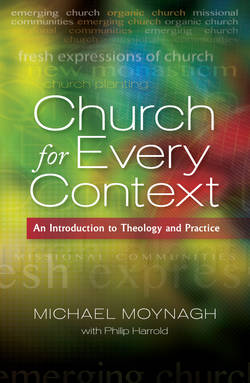Читать книгу Church for Every Context - Michael Moynagh - Страница 61
На сайте Литреса книга снята с продажи.
Fresh Expressions of Church in Britain
ОглавлениеChurch reports do not usually become best-sellers. Since its publication in 2004, Mission-shaped Church has sold over 30,000 copies, reached an international audience and has been credited with reshaping the Church of England’s ecclesiology (Davison and Milbank, 2010, p. 1). It led to the official encouragement of ‘fresh expressions of church’ in the Church of England and the Methodist Church, and this has influenced other denominations in the UK such as the Congregational Federation, the United Reformed Church and the Church of Scotland.
Brian McLaren, from within the emerging church conversation, has found it amazing that an ancient institutional church should experiment with new styles of church alongside existing expressions – ‘to create new wineskins while the existing wineskins were still in use . . .’ He believes that ‘England provides a tremendous laboratory to test new ideas and learn from them’ (McLaren, 2009, pp. 17, 26).
The report pleaded for flexible approaches to the creation of new Christian communities. It urged the church not to rely only on a ‘come to us’ approach to mission, seeking to incorporate Christians into the current pattern of church life. Rather, the church should seek also to go out to people in innovative ways. It called for new expressions of church, perhaps meeting in unusual places at unusual times, to help people toward transformed lives via fresh commitment to Christ. It sought not the demise of the local geographically based church, but its renewal through other types of Christian community alongside it and linked to it.
These ideas were not new. In 1968, a World Council of Churches report proposed that alongside the ‘parish’ new churches, taking diverse shapes, should undertake mission in the many contexts of work and leisure where people now lead their lives (WCC, 1968). Four years later John Taylor, General Secretary of the Church Missionary Society, wrote enthusiastically about ‘little congregations’ of perhaps just two or three Christians, scattered across the settings of everyday life (Taylor, 2004 [1972, pp. 147–52). Lesslie Newbigin expressed similar thoughts five years later (Newbigin, 1977, pp. 115–18).
Yet these ideas were seldom taken up in practice. They seemed very radical, there were few concrete examples to point the way and the need to think about novel expressions of church did not appear urgent to most leaders. By contrast, Mission-shaped Church provided examples of new and different types of church. It charted a way forward for a church that not only felt bewildered by the sweeping changes in the cultural landscape (which had been true of the 1960s as well), but had also experienced some 40 years of numerical decline. It captured a mood.
The last two chapters have described how the church has regularly reproduced among people outside the church. This chapter tells the story of Britain’s experience of fresh expressions of church, which continue this tradition of reproduction. Although new contextual churches are emerging in a number of countries, Britain’s denominations have been at the forefront in recognizing and encouraging them, and so the story may be of some interest to people outside as well as inside the UK.1 The story will be told within an ‘emergence’ framework derived from complexity theories. The chapter starts, therefore, with a brief account of the latter, their theological rationale and the model that will frame the narrative here.
